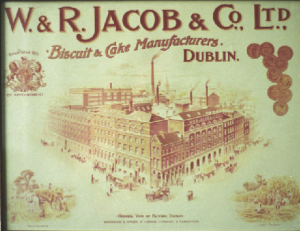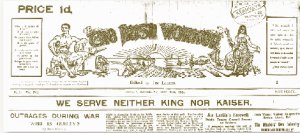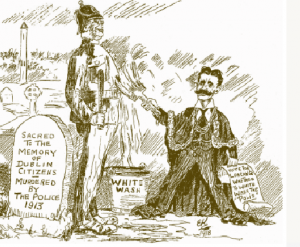Revolutionary genesis?
Published in 20th-century / Contemporary History, Features, Issue 4 (July-August 2013), Volume 21, World War ITourists are often invited, like Doubting Thomas, to thrust their fingers into the bullet holes that mark the sides of the General Post Office. Few visitors to the National Archives pause to run their hands along the words etched into the granite of the wall that runs along Bishop Street. Yet the history of Jacob’s biscuit factory is as important as the GPO in the story of the Irish revolution.
Delia Larkin
 Delia Larkin, sister to Big Jim, was the first to attack Jacob’s in her campaign to organise Dublin’s women workers in spring 1911. She protested against the company’s unfair punishments and exposed corruption in the management, concluding: ‘Jacobs & Co. have no qualms of conscience whatever as far as the workers are concerned; they are out to make a profit, and make it they will, even though it be at the cost of ill-health and disablement to the girls, women, and men of Dublin’. Her words proved prophetic during the 1913 Lockout. In early September of that year, the factory’s managers displayed a notice prohibiting the wearing of the Red Hand membership badge of the Irish Transport and General Workers’ Union (ITGWU). Women who refused to remove the badge were instantly dismissed. Delia Larkin questioned the integrity of the Quaker firm as a ‘Christian employer’ and argued that the company had ‘sealed [its] own doom’.
Delia Larkin, sister to Big Jim, was the first to attack Jacob’s in her campaign to organise Dublin’s women workers in spring 1911. She protested against the company’s unfair punishments and exposed corruption in the management, concluding: ‘Jacobs & Co. have no qualms of conscience whatever as far as the workers are concerned; they are out to make a profit, and make it they will, even though it be at the cost of ill-health and disablement to the girls, women, and men of Dublin’. Her words proved prophetic during the 1913 Lockout. In early September of that year, the factory’s managers displayed a notice prohibiting the wearing of the Red Hand membership badge of the Irish Transport and General Workers’ Union (ITGWU). Women who refused to remove the badge were instantly dismissed. Delia Larkin questioned the integrity of the Quaker firm as a ‘Christian employer’ and argued that the company had ‘sealed [its] own doom’.
The ITGWU’s dispute with Jacob’s stretched into mid-1914, when James Connolly published a long article, ‘The outrages at Jacob’s’, describing the ‘diabolical’ working conditions at the firm. Workers who sought re-employment after the Lockout were summoned for systematic humiliation. Women had their clothes examined and their arms pinched, all the while subjected to ‘a running fire of insulting remarks’. Connolly reported that male employees were forced to undergo medical examinations as if they were ‘recruit[s] for the army’.
As the First World War and the threat of conscription in Ireland escalated, the Irish Worker was dominated by news from the front and anti-enlistment propaganda. The grievances against Jacob’s biscuit factory and other supporters of the employers’ lockout receded from the newspaper’s pages. But they were far from forgotten. In the penultimate issue of the Worker prior to its suppression under the Defence of the Realm Act, Connolly reviewed a new book, Disturbed Dublin: the story of the great strike, which had defended Jacob’s biscuit factory as a public institution that had been ‘maligned and calumniated to an incredible degree . . . [and had become a] . . . victim of a vendetta’. By that account, the ITGWU had disturbed the utopia overseen by Messrs Jacob, but Connolly argued that the true history of events would be ‘like an epic in which the heroes and heroines were the humble men and women who went out in the streets to suffer and starve rather than surrender their right to continue as they chose for the uplifting of their class’.
Jacob’s British Army recruitment drive

Larkin’s Irish Worker, and its successor, James Connolly’s Workers’ Republic, frequently targeted Jacob’s. As the First World War and the threat of conscription in Ireland escalated, the Irish Worker was dominated by news from the front and anti-enlistment propaganda.
The Workers’ Republic, launched in May 1915, focused on propagandising the left’s anti-conscription campaign and delivering war news from an anti-imperialist perspective. Labour’s antagonism towards Jacob’s was again raised, this time in protest at the firm’s participation in a recruitment drive for the British Army. While conscription was not formally instituted, letters from Dublin working men to the Workers’ Republic state that men were being dismissed from some of the city’s most prominent employers with the order to enlist. It was reported that Jacob’s refused to hire any man who could not show army rejection papers. These stories might be dismissed as anecdotal, but it is incontrovertibly documented that G.N. Jacob sat on a committee organised by Lord Wimbourne, director of recruiting in Ireland as well as lord lieutenant, with the purpose of determining the percentage of workers who could be spared from the firms and sent to the front instead. Other committee members included William Martin Murphy of the reviled United Tramways Company, Clery’s department store and the Irish Independent. This alliance smacked of the junta set against the workers in the Lockout and appeared, to the labour left, to be an attempt by Dublin capitalists to rid industry of its most radical elements: ‘blacklegs, pimps, and toadies could be certified as “indispensable”, and the military would do the rest’.
On 18 December 1915, Connolly’s cleverly titled page-one column, ‘Notes on the Front’, made explicit the link between the Lockout and the recruiting efforts by Dublin’s employers; it was ‘The same weapon, the same power derived from the same source’. He called for the destruction of the imperial infrastructure: ‘Anything in Ireland which depends upon the Empire depends upon that which the fortunes of war may destroy at any moment, depends upon that which the progress of enlightenment must destroy in the near future’.
As 1916 dawned, Connolly’s articles became even more specific. Although no particular employers were mentioned, he proclaimed that ‘All factories and workshops owned by people who do not yield allegiance to the Irish government immediately upon its proclamation should at once be confiscated’. In late February 1916, Connolly clearly stated that the Irish Citizen Army was preparing to take up arms against its enemies from 1913. The next month—less than six weeks before the Easter Rising—he named his principle antagonist: ‘For some time back this firm has had its reward by being kept going with government orders . . . Messrs Jacob in 1913–14 used their power over the means of livelihood of their employees to coerce them out of the trade union of their choice on the pain of starvation; now that same firm is again using its power over the means of livelihood of the workers to coerce them into an army that stood ready to shoot them down in 1913–14’.
Why was Jacob’s occupied in 1916?

Ernest Kavanagh’s ‘Lorcan’s Whitewash’, Irish Worker, 10 January 1914. Lord Mayor Lorcan G. Sherlock whitewashes a delighted DMP constable in Glasnevin cemetery, a reference to the lord mayor’s defence of the DMP’s conduct in the violent clashes of the opening days of the Lockout. On 16 February the Dublin Disturbances Commission published their report into the violence of five months earlier. To nobody’s surprise, the report fully exonerated the DMP’s conduct on 30–31 August 1913.
For historians, one of the most puzzling aspects of the Easter Rising is the military council’s decision to occupy Jacob’s biscuit factory. Rank-and-file Volunteers’ hostility to Connolly’s socialism has precluded analyses of the ideological motivations behind the occupation of battle sites, but we should not assume that the rank-and-file would have been privy to the motivations for the council’s plans, or that the Citizen Army would be sent to sites chosen by Connolly and the Volunteers to places selected by Pearse. As Connolly declared on the eve of the Rising, there was now no such thing as the Citizen Army or the Volunteers but only the ‘army of the Irish Republic’.
If we trace the labour left’s long campaign against Jacob’s biscuit factory, stretching from the founding of the Irish Worker in 1911 right up to the weeks prior to the Easter Rising, we are presented with a coherent narrative of class war in which Jacob’s is a central institution. Of course, unless a cache of papers miraculously surfaces, we will never be certain why and how the battlegrounds of 1916 were chosen. Yet Connolly’s journalism presents a strong case for the occupation of Jacob’s as an expression of his policy of conscripting imperialist industries in the construction of the new republic. The relationship between the labour left and Jacob’s biscuit factory is not simply a battle of ideas but a bloody struggle for the transformation of Ireland. HI
Lauren Arrington lectures in history at the Institute of Irish Studies, University of Liverpool.
Read More : ‘Benevolent employer in the Quaker tradition’?
Further reading
R.M. Fox, The history of the Irish Citizen Army (Dublin, 1943).
















